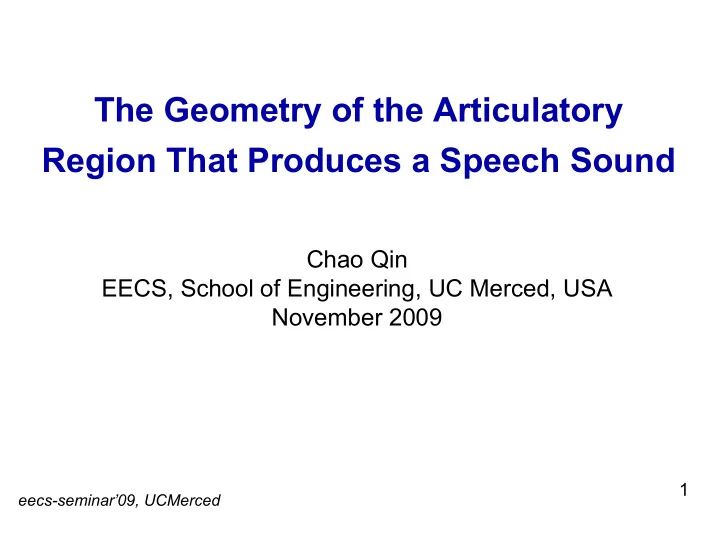

The Geometry of the Articulatory Region That Produces a Speech Sound Chao Qin EECS, School of Engineering, UC Merced, USA November 2009 1 eecs-seminar’09, UCMerced
Outline • Introduction and motivation • Nonuniqueness of the inverse mapping • Prediction error of individual articulators • Nonuniqueness of individual articulators • Conclusions 2
Introduction • Articulatory inversion – Recovering vocal tract shapes from acoustics – Still an open research problem! • Nonuniqueness of the inverse mapping – Model-based approaches: Atal et al’78, Boe et al’92 – Data-driven approaches: Qin&Carreira-Perpiñán’07 3
Introduction Nonuniqueness of any articulator Nonuniqueness of the entire VT Nonuniqueness of the entire VT Nonuniqueness of every articulator • Questions – Is recovering a portion of the vocal tract simpler than recovering the entire VT? – How to quantify the difficulty? • Why recovering portions of the vocal tract? – Useful for facial animation (lips and anterior tongue) and diagnosis of speech disorders (velum height) in dysarthria – Useful for separating linguistic information from speakers’ idiosyncrasy • Approaches – Parametric methods: model-based inversion – Nonparametric methods: fewer assumptions 4
PART I: Prediction Error of Individual Articulators in Inverse Models 5
Articulatory databases 6
Prediction error of individual articulators • Dataset – MOCHA-TIMIT • Train: 10000 frames • Valid: 4000 frames • Test: 15 utterances – EMA after “mean-filtering” – 12-order line spectral frequency (LSF) • Inversion by neural networks – 7 MLPs for different portions of the front VT – 6 MLPs for individual articulators – 1 RBF for entire vocal tract: • Model parameters – MLPs: single layer with 100 hidden units λ = = σ = regulariza tion 0 . 1 , M 600 basis functions, bandwidth 0 . 1 – RBF: 7
Experimental results: vocal tract inversion Portions of the VT by Whole VT by Individual articulator by MLPs MLPs RBF RMSE Correlatio RMSE Correlation RMSE Correlation n ULx 1.00 0.51 0.99 0.51 1.02 0.48 ULy 1.36 0.57 1.33 0.60 1.36 0.58 LLx 1.32 0.49 1.28 0.51 1.35 0.47 LLy 2.96 0.70 2.93 0.71 2.95 0.71 LIx 0.94 0.48 0.92 0.51 0.95 0.47 LIy 1.33 0.75 1.32 0.75 1.35 0.74 TTx 2.74 0.72 2.71 0.73 2.79 0.71 TTy 3.06 0.77 3.01 0.78 3.05 0.77 TBx 2.37 0.77 2.36 0.77 2.44 0.75 TBy 2.63 0.74 2.60 0.74 2.65 0.74 TDx 2.21 0.74 2.19 0.75 2.26 0.72 TDy 2.75 0.59 2.72 0.59 2.78 0.59 Vx 0.51 0.69 0.52 0.68 0.52 0.68 8 Vy 0.46 0.70 0.46 0.70 0.46 0.70
Normalized estimation error The entire dataset for speaker fsew0 = − i i i ˆ e a a Estimation errors: j j j 9
Relative estimation error for each articulator 1 / 2 1 / 2 1 1 ~ ∑ = 2 − − Σ Σ Σ ⇒ λ λ 1 / 2 1 / 2 i i tr( ) / r e r e r 2 2 i 1 Σ : covariance of each articulato r' s position r Σ : covariance of each articulato r' s error e 10
PART II: Nonuniqueness of Individual Articulators 11
Wisconsin X-ray microbeam database jw11 43260 { x , y } = n n n 1 ∈ ℜ 16 D x : articulato ry positions n ∈ ℜ 20 D y : 20 - order LPC 12 n
Multimodality of the inverse set • Nonparametric algorithm – Search multimodality in individual 2D articulatory space (like Qin&Carreira-Perpiñán’07) – Analyze the geometry of the inverse set by shape statistics AC Y ART X = ≤ ⊂ I ( y ) { x | d ( y , y ) r } X m m x 1 y x 2 y – Given an acoustic vector I ( y ) – Find its inverse set σ = 6 mm – Count number of modes (of kernel density estimate of bandwidth – Compute shape statistics – Repeat for all acoustic vectors in the dataset 13
Shape statistics of the inverse set • Characterizing the geometry by the shape statistics – Eigenvalues of the covariance matrix λ ≥ λ – measure the spread of the inverse set along its principal axes 1 2 λ λ ⇒ 1 . and are small tightly concentrat ed and 0D manifold 2 1 λ << λ ⇒ 2. elongated shape and 1D manifold 2 1 ⇒ 3. Otherwise complex shape = r 0 . 2 • These shape statistics only depend on the acoustic distance 14
Eigenvalue plots for some articulators 15
Percentage of nonuniqueness in the dataset Extremely infrequent Quite infrequent 16
Histogram plots for each articulator 17
Histogram plot for the entire vocal tract 18
Unique frames in T1 space 19
Nonunique frames in T1 space 20
Conclusion • Nonuniqueness affects all the articulators of the vocal tract • Some or even all articulators may be strongly constrained • The normalized inversion error by neural nets is approximately the same over all articulators • Generally, the set of articulatory shapes that correspond to a given sound is relatively constrained around a roughly spherical region in articulatory space (0D manifold, eg. vowels) • Many frames do show more complex shapes: very elongated in a straight or curved path (1D manifold, eg. glides /l/ and /w/) or multimodality (>=2D manifold, eg. /r/) or even more complex (eg. /m/) 21
Acknowledge • Work funded by NSF award IIS-0754089 and IIS-0711186 22
Recommend
More recommend